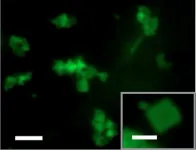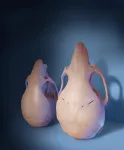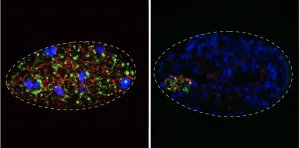(Press-News.org) Chemists have developed a nanomaterial that they can trigger to shape shift -- from flat sheets to tubes and back to sheets again -- in a controllable fashion. The Journal of the American Chemical Society published a description of the nanomaterial, which was developed at Emory University and holds potential for a range of biomedical applications, from controlled-release drug delivery to tissue engineering.
The nanomaterial, which in sheet form is 10,000 times thinner than the width of a human hair, is made of synthetic collagen. Naturally occurring collagen is the most abundant protein in humans, making the new material intrinsically biocompatible.
"No one has previously made collagen with the shape-shifting properties of our nanomaterial," says Vincent Conticello, senior author of the finding and Emory professor of biomolecular chemistry. "We can convert it from sheets to tubes and back simply by varying the pH, or acid concentration, in its environment."
The Emory Office of Technology Transfer has applied for a provisional patent for the nanomaterial.
First authors of the finding are Andrea Merg, a former post-doctoral fellow in the Conticello lab who is now at the University of California Merced, and Gavin Touponse, who did the work as an Emory undergraduate and is now in medical school at Stanford. The work was a collaboration between Emory and scientists from the Argonne National Laboratory, the Paul Scherrer Institute in Villigen, Switzerland, and the Center for Cellular Imaging and NanoAnalytics at the University of Basel.
Collagen is the main structural protein in the body's connective tissue, such as cartilage, bones, tendons, ligaments and skin. It is also abundant in blood vessels, the gut, muscles and in other parts of the body.
Collagen taken from other mammals, such as pigs, is sometimes used for wound healing and other medical applications in humans. Conticello's lab is one of only about a few dozen around the world focused on developing synthetic collagen suitable for applications in biomedicine and other complex technologies. Such synthetic "designer" biomaterials can be controlled in ways that natural collagen cannot.
"As far back as 30 years ago, it became possible to control the sequence of collagen," Conticello says. "The field has really picked up steam, however, during the past 15 years due to advances in crystallography and electron microscopy, which allows us to better analyze structures at the nano-scale."
The development of the new shape-shifting nanomaterial at Emory was "a fortuitous accident," Conticello says. "There was an element of luck to it and an element of design."
The collagen protein is composed of a triple helix of fibers that wrap around one another like a three-stranded rope. The strands are not flexible, they're stiff like pencils, and they pack together tightly in a crystalline array.
The Conticello lab has been working with collagen sheets that it developed for a decade. "A sheet is one large, two-dimensional crystal, but because of the way the peptides pack it's like a whole bunch of pencils bundled together," Conticello explains. "Half the pencils in the bundle have their leads pointing up and the other half have their eraser-end pointing up."
Conticello wanted to try to refine the collagen sheets so that each side would be limited to one functionality. To take the pencil analogy further, one surface of the sheet would be all lead points and the other surface would be all erasers. The ultimate goal was to develop collagen sheets that could be integrated with a medical device by making one surface compatible with the device and the other surface compatible with functional proteins in the body.
When the researchers engineered these separate types of surfaces into single collagen sheets, however, they were surprised to learn that it caused the sheets to curl up like scrolls. They then found that the shape-shifting transition was reversible -- they could control whether a sheet was flat or scrolled simply by changing the pH of the solution it was in. They also demonstrated that they could tune the sheets to shape shift at particular pH levels in a way that could be controlled at the molecular level through design.
"It's particularly interesting that the condition around which the transition occurs is a physiological condition," Conticello says. "That opens the potential to find a way to load a therapeutic into a collagen tube under controlled, laboratory conditions. The collagen tube could then be tuned to unfurl and release the drug molecules it contains after it enters the pH environment of a human cell."
Emory scientists who contributed to measuring and characterizing the new nanomaterial and co-authored the paper include chemistry professors Brian Dyer and Khalid Salaita; chemistry graduate students Alisina Bazrafshan and Helen Siaw; and Arthur McCanna from the Robert P. Apkarian Integrated Electron Microscopy Core.
INFORMATION:
Co-authors from the Paul Scherrer Institute helped characterize the three-dimensional structure of the crystalline assemblies and further analyze the nanomaterial. They include Jan Pieter Abrahams, Thorsten Blum and Eric van Genderen. Xiaobing Zuo from the Argonne National Laboratory also contributed as a co-author of the project.
The work was supported by funds from the National Science Foundation, the Swiss National Science Foundation and the National Institutes of Health.
Alexandria, Va., USA -- The COVID-19 pandemic has significantly impacted dental education and training. The study "COVID-19 and Dental and Dental Hygiene Students' Career Plans," published in the JDR Clinical & Translational Research (JDR CTR), examined the short-term impact of the COVID-19 pandemic on dental hygiene and dental students' career intentions.
An anonymous online survey was emailed to dental and dental hygiene students enrolled at Virginia Commonwealth University School of Dentistry, Richmond, USA. The survey consisted of 81 questions that covered a wide range of topics including demographics, anticipated educational debt, career plans post-graduation, ...
CHAMPAIGN, Ill. -- In almost all successful advertising campaigns, an appeal to emotion sparks a call-to-action that motivates viewers to become consumers. But according to research from a University of Illinois Urbana-Champaign expert who studies consumer information-processing and memory, emotionally arousing advertisements may not always help improve consumers' immediate memory.
A new paper co-written by Hayden Noel, a clinical associate professor of business administration at the Gies College of Business at Illinois, finds that an ad's emotional arousal can have a negative effect on immediate ...
Using stem cells to regenerate parts of the skull, scientists corrected skull shape and reversed learning and memory deficits in young mice with craniosynostosis, a condition estimated to affect 1 in every 2,500 infants born in the United States, according to the Centers for Disease Control and Prevention. The only current therapy is complex surgery within the first year of life, but skull defects often return afterward. The study, supported by the National Institute of Dental and Craniofacial Research (NIDCR), could pave the way for more effective and less invasive therapies for children with craniosynostosis. ...
Humans feeding leftover lean meat to wolves during harsh winters may have had a role in the early domestication of dogs, towards the end of the last ice age (14,000 to 29,000 years ago), according to a study published in Scientific Reports.
Maria Lahtinen and colleagues used simple energy content calculations to estimate how much energy would have been left over by humans from the meat of species they may have hunted 14,000 to 29,000 years that were also typical wolf prey species, such as horses, moose and deer. The authors hypothesized that if wolves and humans had hunted the same animals during harsh winters, humans would have killed wolves to reduce competition rather than domesticate them. With the exception of Mustelids such as weasels, ...
"Nature red in tooth and claw" - The battle to survive is fought down to the level of our genes. Toxin-antidote elements are gene pairs that spread in populations by killing non-carriers. Now, research by the Burga lab at IMBA and the Kruglyak lab at the University of California, Los Angeles shows that these elements are more common in nature than first thought and have evolved a wide range of mechanisms to force their inheritance and propagate in populations - a parasite within the genome.
Originally described in the model nematode Caenorhabditis elegans, toxin-antidote elements consist of two linked genes, a toxin and its antidote. While the toxin is loaded into eggs by mothers, only embryos that inherit the element express the antidote. Thus, the ...
The National Human Genome Research Institute (NHGRI) within the National Institutes of Health (NIH) has released a new action agenda for a diverse genomics workforce. This ambitious set of goals, objectives, and implementation strategies details NHGRI's plans for enhancing the diversity of the genomics workforce by 2030.
"To reach its full potential, the field of genomics requires a workforce that better reflects the diversity of the U.S. population," NHGRI Director Eric Green, M.D., Ph.D., said. "Fostering an appropriately diverse genomics workforce of the future requires an immediate and substantial commitment ...
Noncognitive skills and cognitive abilities are both important contributors to educational attainment -- the number of years of formal schooling that a person completes -- and lead to success across the life course, according to a new study from an international team led by researchers at Columbia University Mailman School of Public Health, the University of Texas at Austin, and Vrije Universiteit Amsterdam. The research provides evidence for the idea that inheriting genes that affect things other than cognitive ability are important for understanding differences in people's life outcomes. Until now there had been questions about what these noncognitive skills are and how much they really matter for life outcomes. The new findings are published ...
What The Study Did: Under a range of assumptions of presymptomatic transmission and transmission from individuals with infection who never develop symptoms, the model presented here estimated that more than half of transmission comes from asymptomatic individuals.
Author: Jay C. Butler, M.D., of the U.S. Centers for Disease Control and Prevention in Atlanta, is the corresponding author.
To access the embargoed study: Visit our For The Media website at this link https://media.jamanetwork.com/
(doi:10.1001/jamanetworkopen.2020.35057)
Editor's Note: The article includes funding/support disclosures. Please see the article for additional information, including other authors, author contributions and affiliations, conflict of interest and ...
What The Study Did: Population data from Denmark were used to examine whether age at exposure to negative experiences in childhood and adolescence (parents' unemployment, incarceration, mental disorders, death and divorce, and the child's foster care experiences) was associated with outcomes in early adulthood.
Author: Signe Hald Andersen, Ph.D., of the Rockwool Foundation Research Unit in Copenhagen, Denmark, is the corresponding author.
To access the embargoed study: Visit our For The Media website at this link https://media.jamanetwork.com/
(doi:10.1001/jamanetworkopen.2020.32769)
Editor's Note: The article includes funding/support disclosures. Please see the article for additional information, including other authors, author contributions and affiliations, ...
What The Study Did: To adapt to broader public health initiatives around COVID-19, researchers developed a drive-through intraocular pressure (IOP) screening clinic to minimize COVID-19 exposure for patients and clinicians by measuring eye pressure in the unconventional setting of a clinic parking lot.
Authors: Miel Sundararajan, M.D., of the University of California, San Francisco, is the corresponding author.
To access the embargoed study: Visit our For The Media website at this link https://media.jamanetwork.com/
(doi:10.1001/jamaophthalmol.2020.6073)
Editor's Note: The article includes conflict of interest and funding/support disclosures. Please see the article ...



